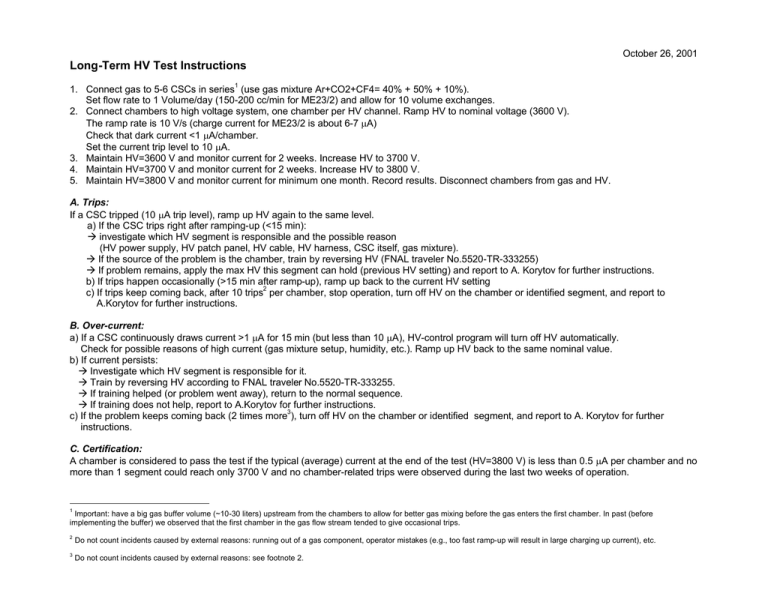Long-Term HV Test Instructions
advertisement

October 26, 2001 Long-Term HV Test Instructions 1. Connect gas to 5-6 CSCs in series1 (use gas mixture Ar+CO2+CF4= 40% + 50% + 10%). Set flow rate to 1 Volume/day (150-200 cc/min for ME23/2) and allow for 10 volume exchanges. 2. Connect chambers to high voltage system, one chamber per HV channel. Ramp HV to nominal voltage (3600 V). The ramp rate is 10 V/s (charge current for ME23/2 is about 6-7 µA) Check that dark current <1 µA/chamber. Set the current trip level to 10 µA. 3. Maintain HV=3600 V and monitor current for 2 weeks. Increase HV to 3700 V. 4. Maintain HV=3700 V and monitor current for 2 weeks. Increase HV to 3800 V. 5. Maintain HV=3800 V and monitor current for minimum one month. Record results. Disconnect chambers from gas and HV. A. Trips: If a CSC tripped (10 µA trip level), ramp up HV again to the same level. a) If the CSC trips right after ramping-up (<15 min): à investigate which HV segment is responsible and the possible reason (HV power supply, HV patch panel, HV cable, HV harness, CSC itself, gas mixture). à If the source of the problem is the chamber, train by reversing HV (FNAL traveler No.5520-TR-333255) à If problem remains, apply the max HV this segment can hold (previous HV setting) and report to A. Korytov for further instructions. b) If trips happen occasionally (>15 min after ramp-up), ramp up back to the current HV setting c) If trips keep coming back, after 10 trips2 per chamber, stop operation, turn off HV on the chamber or identified segment, and report to A.Korytov for further instructions. B. Over-current: a) If a CSC continuously draws current >1 µA for 15 min (but less than 10 µA), HV-control program will turn off HV automatically. Check for possible reasons of high current (gas mixture setup, humidity, etc.). Ramp up HV back to the same nominal value. b) If current persists: à Investigate which HV segment is responsible for it. à Train by reversing HV according to FNAL traveler No.5520-TR-333255. à If training helped (or problem went away), return to the normal sequence. à If training does not help, report to A.Korytov for further instructions. c) If the problem keeps coming back (2 times more3), turn off HV on the chamber or identified segment, and report to A. Korytov for further instructions. C. Certification: A chamber is considered to pass the test if the typical (average) current at the end of the test (HV=3800 V) is less than 0.5 µA per chamber and no more than 1 segment could reach only 3700 V and no chamber-related trips were observed during the last two weeks of operation. 1 Important: have a big gas buffer volume (~10-30 liters) upstream from the chambers to allow for better gas mixing before the gas enters the first chamber. In past (before implementing the buffer) we observed that the first chamber in the gas flow stream tended to give occasional trips. 2 Do not count incidents caused by external reasons: running out of a gas component, operator mistakes (e.g., too fast ramp-up will result in large charging up current), etc. 3 Do not count incidents caused by external reasons: see footnote 2.




